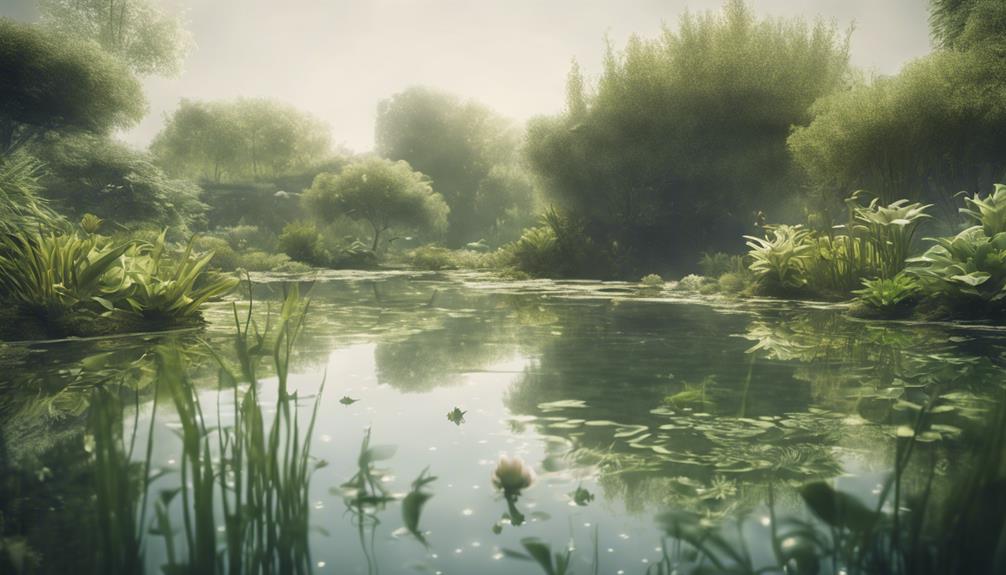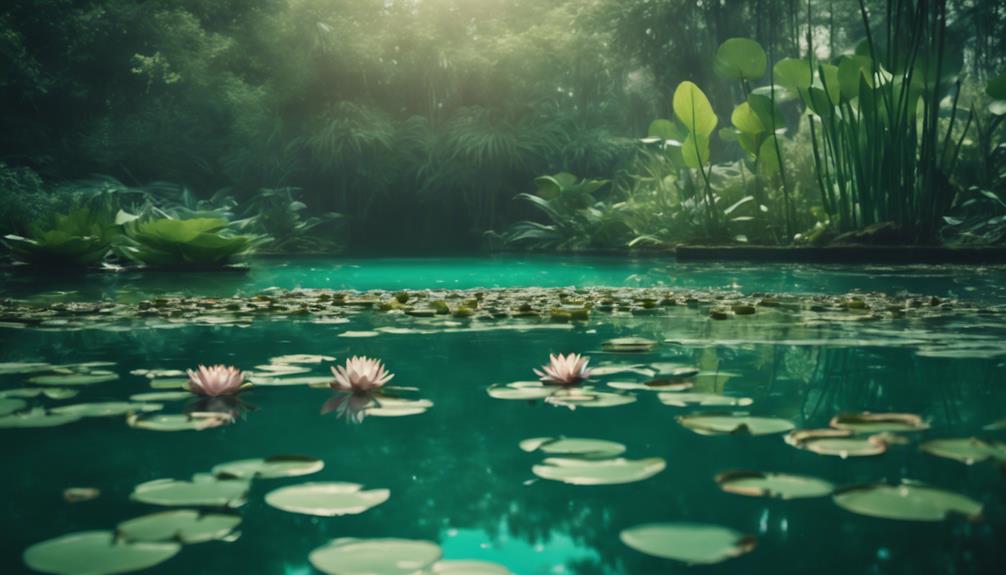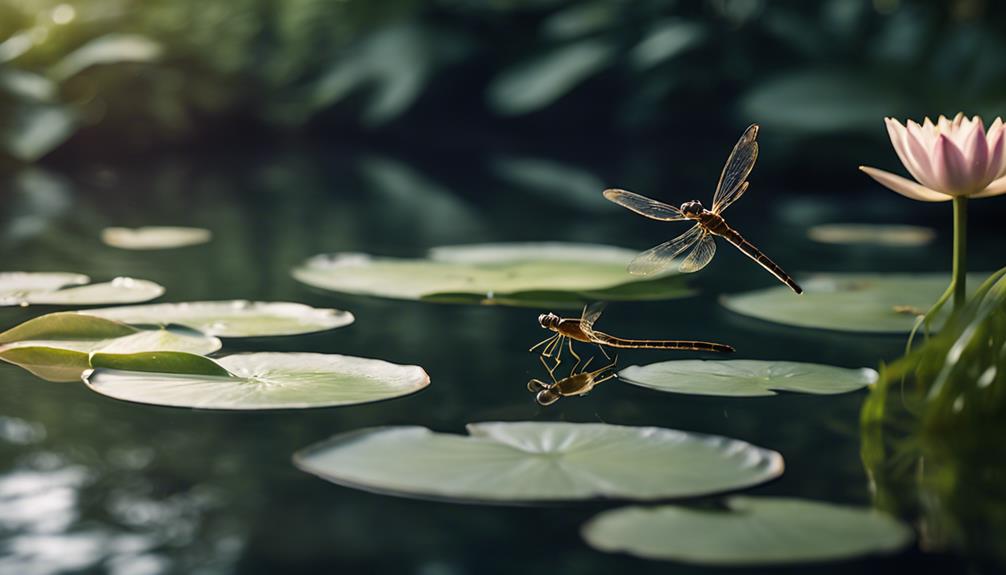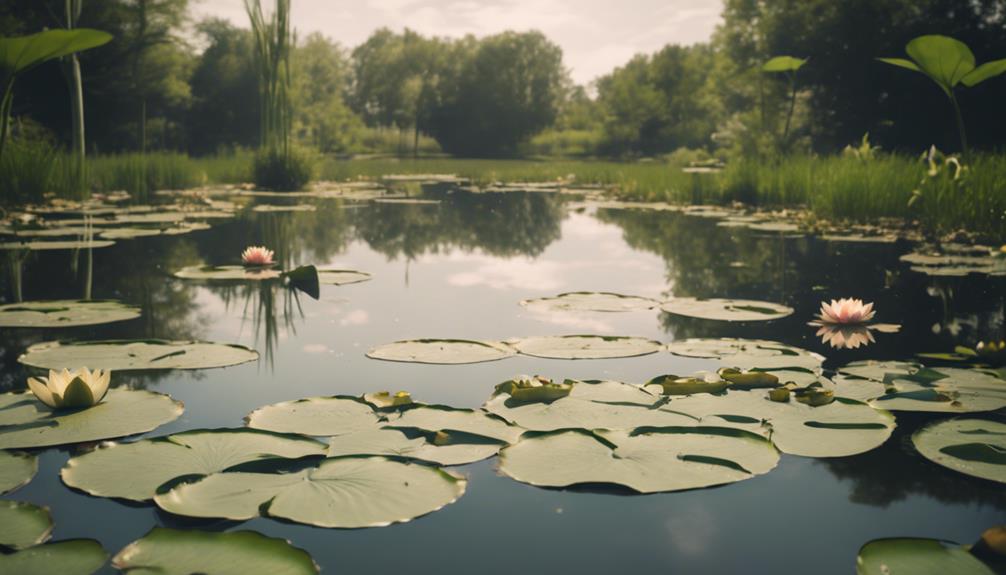You can create a thriving wildlife-friendly pond by introducing beneficial bacteria and enzymes that break down organic matter, reducing harmful substances and promoting a balanced ecosystem. Regular monitoring of pH, ammonia, nitrite, and nitrate levels helps identify imbalances and take corrective action. Natural sludge and muck removers, like beneficial microorganisms and enzymes, effectively reduce organic waste, creating a welcoming environment for aquatic life. By adopting eco-friendly pond treatment options, you'll minimize the need for harsh chemicals and major maintenance. Now, discover how to optimize your pond's ecosystem for a harmonious coexistence with nature.
Table of Contents
Key Takeaways
- Beneficial bacteria and enzymes promote a balanced ecosystem, maintaining high-quality water and a thriving environment for aquatic life.
- Eco-friendly pond treatment options, like natural bacteria boosters, minimize the need for harsh chemicals and major maintenance.
- Regular water testing and maintenance are essential to identify imbalances and take corrective action, ensuring a healthy ecosystem.
- Non-toxic algae control solutions, such as PondPerfect, target the root causes of algae growth, promoting a clear water environment.
- Wildlife-friendly treatment products focus on natural bacteria boosters, enhancing the ecosystem and creating a welcoming environment for fish and other aquatic life.
Eco-Friendly Pond Treatment Options
When maintaining a thriving fish pond, you can opt for eco-friendly treatment options that harness the power of beneficial bacteria and enzymes to promote a balanced ecosystem.
These microorganisms play a vital role in breaking down organic matter, reducing the accumulation of harmful substances, and maintaining high-quality water.
By introducing beneficial bacteria and enzymes into your pond treatment, you'll create an environment that's conducive to healthy fish and aquatic life.
This approach not only maintains a balanced ecosystem but also minimizes the need for major maintenance in the future.
Regular monitoring of pH, ammonia, nitrite, and nitrate levels helps identify imbalances and take corrective action.
By adopting eco-friendly pond treatment options, you'll be able to maintain a healthy and thriving fish pond that's in harmony with nature.
This approach prioritizes the well-being of your fish and other aquatic organisms, while also promoting a sustainable and environmentally friendly pond management strategy.
Safe and Natural Solutions
You can rely on beneficial bacteria and enzymes as safe and natural solutions for wildlife-friendly pond water treatment, effectively breaking down organic waste and promoting a balanced ecosystem.
These microorganisms work harmoniously to decompose organic matter, reducing the need for harsh chemicals. By introducing beneficial bacteria and enzymes, you'll create a thriving environment for aquatic life.
Additionally, these natural solutions can help control algae growth, which can deplete oxygen levels and harm fish. However, if algae growth becomes excessive, you can use algaecides specifically formulated for fish ponds, but exercise caution to avoid harming aquatic life.
Regular water testing and maintenance are vital to maintain a balanced ecosystem. By monitoring pH, ammonia, nitrite, and nitrate levels, you'll identify imbalances before they become major issues.
Biological Pond Treatment Methods

When you incorporate biological pond treatment methods into your wildlife-friendly pond's maintenance routine, you're taking a vital step towards achieving a balanced ecosystem.
You'll be introducing natural beneficial bacteria that break down organic waste, promoting a thriving environment for aquatic life.
Natural Beneficial Bacteria
Beneficial bacteria, naturally present in aquatic ecosystems, play a crucial role in maintaining a balanced pond environment by breaking down organic waste into harmless byproducts.
As you consider pond treatments, understanding the importance of these microorganisms is paramount. They're the unsung heroes that keep your pond healthy and thriving.
By introducing beneficial bacteria into your pond, you're promoting a natural balance that limits algae growth and reduces the need for future maintenance. These bacteria break down organic matter, which in turn lowers nutrient levels and prevents excessive algae growth that can harm aquatic life.
By using beneficial bacteria and enzymes, you're taking a proactive approach to maintaining a healthy ecosystem. This approach not only saves you time and resources but also safeguards the well-being of your fish and other aquatic organisms.
Pond Ecosystem Balance
Maintaining a delicate balance between aquatic life and their environment is vital in a wildlife-friendly pond, as it directly impacts water quality and ecosystem health.
As you work to create a thriving pond ecosystem, you'll want to focus on biological pond treatment methods that promote balance and harmony. By introducing beneficial bacteria and enzymes, you can break down organic waste and excess nutrients that can lead to algae growth and water quality issues.
Regular water testing and maintenance are essential for identifying imbalances and taking corrective action to maintain a healthy pond ecosystem. By monitoring pH, ammonia, nitrite, and nitrate levels, you can confirm your pond's water is safe and healthy for aquatic plants and animals.
A balanced ecosystem can minimize the need for major pond treatments, reducing the risk of harming fish and other aquatic life. By taking a proactive approach to pond ecosystem balance, you can create a sustainable and healthy environment for wildlife, while also enjoying a beautiful and thriving pond.
Non-Toxic Algae Control Solutions
You can opt for non-toxic algae control solutions that target the root causes of algae growth, rather than just treating its symptoms.
Excess algae can turn your pond's water murky, making it difficult to maintain a balanced ecosystem. However, introducing beneficial bacteria can help break down organic matter, promoting a clear water environment.
Products like PondPerfect are specifically designed to control algae growth while maintaining a safe and healthy environment for fish and other aquatic life.
When choosing a non-toxic algae control solution, it's essential to select products that are safe for fish ponds and follow the instructions carefully.
Regular water testing and maintenance are crucial to ensure the treatment's effectiveness and the overall health of your pond.
By introducing beneficial bacteria and enzymes, you can prevent the build-up of harmful substances and promote a balanced ecosystem. This approach not only controls algae growth but also creates a thriving environment for your fish and other wildlife.
Pond Water Clarification Strategies

Pond water clarification strategies, such as introducing beneficial microorganisms and enzymes, can substantially improve water transparency by breaking down organic matter and excess nutrients that fuel algae growth.
By doing so, you'll create a more balanced ecosystem in your water garden, reducing the need for major maintenance down the line.
Beneficial bacteria, in particular, are effective in breaking down organic matter, including algae and sludge, accelerating the decomposition process and leading to clearer water.
Regular water testing and maintenance are vital to maintaining your pond's health.
Monitoring pH, ammonia, nitrite, and nitrate levels helps identify imbalances and take prompt action.
Note that algaecides can be used to control excessive algae growth, but they must be specifically formulated for fish ponds and applied carefully to safeguard the well-being of your fish.
Natural Sludge and Muck Removers
Beneficial microorganisms and enzymes, introduced as natural sludge and muck removers, effectively break down organic waste, reducing the accumulation of muck and sludge at the pond's bottom.
These natural removers work in harmony to create a balanced ecosystem, promoting a healthier pond environment. Beneficial bacteria, in particular, play a vital role in decomposing organic waste into harmless byproducts.
By doing so, they help limit the growth of algae and sludge, which can deplete oxygen levels and create an unhealthy environment for fish and other aquatic life.
Regularly introducing these natural removers into your pond can substantially reduce the need for chemical-based treatments. Plus, they're safe for fish and other aquatic life, making them an excellent choice for maintaining a thriving fish pond.
By incorporating natural sludge and muck removers into your pond maintenance routine, you'll be creating a more balanced and sustainable ecosystem.
This, in turn, will reduce the likelihood of water quality issues and create a welcoming environment for the wildlife that call your pond home.
Wildlife-Friendly Treatment Products

When selecting wildlife-friendly treatment products, you'll want to focus on natural bacteria boosters that enhance the ecosystem's natural processes.
You can also consider eco-friendly chemical alternatives that minimize harm to aquatic life.
Natural Bacteria Boosters
By incorporating natural bacteria boosters into your wildlife-friendly pond water treatment routine, you can effectively enhance the decomposition of organic waste, promoting a balanced ecosystem.
Beneficial bacteria play a vital role in breaking down organic waste into harmless byproducts, which in turn maintains a clean and healthy pond environment.
In a natural pond, these microorganisms thrive, keeping the water clean and clear.
Introducing beneficial bacteria and enzymes into your pond ecosystem can greatly accelerate the breakdown of organic matter.
This reduces nutrient levels, limiting excessive algae growth and creating an ideal environment for aquatic life to flourish.
Regular water testing and maintenance are essential to maintain the well-being of your pond's ecosystem.
By monitoring pH, ammonia, nitrite, and nitrate levels, you can identify imbalances and take corrective action to maintain a thriving pond.
Eco-Friendly Chemical Alternatives
In your quest for a thriving wildlife-friendly pond, you'll want to explore eco-friendly chemical alternatives that prioritize the well-being of your aquatic inhabitants and the environment.
Beneficial bacteria-based treatments, like PondPerfect, are a natural and eco-friendly way to break down organic waste and promote a balanced ecosystem. These treatments introduce beneficial bacteria that outcompete harmful substances, creating a healthy environment for your pond's inhabitants.
Alternatively, natural treatments like Airmax MuckAway can be used to break down muck and sludge, eliminating the need for harsh chemicals.
When controlling algae growth, opt for algaecide pond treatments specifically formulated for fish ponds, such as API POND ALGAEFIX, and follow instructions carefully to safeguard fish safety.
Aquatic herbicides, like Aquascape Algaecide, can also be used to eliminate pond weeds, but verify that you identify the specific plants causing problems and follow manufacturer instructions to minimize the impact on beneficial plants and organisms.
Environmental Benefits of Eco-Treatments
Eco-treatments for pond water offer a multitude of environmental benefits, chief among them the promotion of a balanced ecosystem that supports a diverse range of aquatic life.
By using eco-treatments, you're creating a thriving water garden that's teeming with life. These natural treatments reduce excess nutrients, control algae growth, and maintain healthy oxygen levels, keeping the water clean and clear.
Moreover, eco-treatments break down organic matter, reducing the need for chemical algaecides and herbicides that can harm aquatic organisms and contaminate waterways.
By choosing eco-friendly options, you're minimizing your environmental footprint and helping to protect local waterways and wildlife habitats from pollution and degradation. This not only preserves water quality but also prevents pollution and protects public health and safety, as emphasized by the Environmental Protection Agency.
Additionally, eco-treatments reduce carbon dioxide and other greenhouse gas emissions, contributing to a more sustainable future.
Frequently Asked Questions
How Do I Clear My Pond Water Without Killing Fish?
To clear your pond water without harming fish, you're wise to prioritize fish safety. Implement pond aeration to increase oxygen levels, promoting water clarity and a healthy environment for your aquatic friends to thrive in.
How Do You Treat Pond Water Naturally?
As you gaze into your serene pond, you're likely wondering how to treat the water naturally. You can start by implementing pond aeration to increase oxygen levels, improving water circulation and natural filtration, creating a healthy ecosystem.
What Can I Put in My Pond to Keep the Water Clear?
To keep your pond water clear, you can introduce beneficial bacteria to break down organic matter, and consider pond aeration to increase oxygen levels, which will improve water clarity and create a healthy environment for aquatic life.
How to Keep a Pond Algae Free?
To keep your pond algae-free, you'll want to focus on Pond Aeration, which increases oxygen levels, and Algae Prevention methods like introducing beneficial bacteria, which break down organic matter, promoting Water Clarity and a balanced ecosystem.
Conclusion
As you gaze out at your thriving pond, remember that the ripples of your eco-friendly treatment choices extend far beyond its borders.
By embracing wildlife-friendly pond water treatment options, you're not only maintaining a healthy aquatic ecosystem but also casting a vote for a greener, more sustainable future.
Your pond becomes a beacon, radiating positive change into the surrounding environment, where every droplet of water and every breath of air is a demonstration to the power of responsible stewardship.

